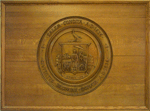Witch House: Difference between revisions
mNo edit summary |
mNo edit summary |
||
| Line 1: | Line 1: | ||
Situated on the corner of Summer and Essex Streets, the Witch House, also know as the Corwin House, was built in the 1670's (or earlier) and is one of the oldest dwellings in the United States. Jonathan Corwin, a magistrate during the witchcraft hysteria of 1692 held many pre-trial examinations here of the accused witches. | Situated on the corner of Summer and Essex Streets, the '''Witch House''', also know as the Corwin House, was built in the 1670's (or earlier) and is one of the oldest dwellings in the United States. Jonathan Corwin, a magistrate during the witchcraft hysteria of 1692 held many pre-trial examinations here of the accused witches. | ||
Corwin bought the house in 1675 from Capt. Nathaniel Davenport, who built it. | Corwin bought the house in 1675 from Capt. Nathaniel Davenport, who built it. | ||
The building underwent more changes when George P. Farrington owned in in the mid 1800's and he attached a drugstore to the east side front. | The building underwent more changes when George P. Farrington owned in in the mid 1800's and he attached a drugstore to the east side front. | ||
Revision as of 12:20, 29 January 2010
Situated on the corner of Summer and Essex Streets, the Witch House, also know as the Corwin House, was built in the 1670's (or earlier) and is one of the oldest dwellings in the United States. Jonathan Corwin, a magistrate during the witchcraft hysteria of 1692 held many pre-trial examinations here of the accused witches. Corwin bought the house in 1675 from Capt. Nathaniel Davenport, who built it. The building underwent more changes when George P. Farrington owned in in the mid 1800's and he attached a drugstore to the east side front. The Witch House opened to the public as a museum in 1947 and is owned by the city.
In 1944, when threatened with destruction, The Witch House became the catalyst that launched a wave of restoration in Salem. Historic Salem Inc. raised the $42,500 needed to move and restore the building. The new museum officially opened to the public in 1948 as a furnished historic site.
The building was moved in the winter of 1945 to allow widening of North Street. Also as part of that project, the Bowditch House was relocated on North Street next to the Witch House. The Corwin House was moved back 35 feet and a new pitched roof (a recreation of the original)was put on at this time.
In 2008, grant money was received for repairs and to make the house wheelchair accessible.
The Park and Recreation Commission denied a request by the group "Spirit Finders" to check the house for paranormal activity in the winter of 2008.
See Also
- Vertical File in Salem Collection - Witch House
- The Witch House Salem web.
- "Salem to market Witch House: city wants to make the most of its historic attraction" Salem News, Apr. 11, 2003, p. A1
- "Pitch roof soon to replace Witch House gambrel" Salem Evening News, Nov. 23, 1945, p. 15
- Witch House restoration speeded up" Salem Evening News, Nov. 6, 1945, p.?
- "Witch House gets money for repairs, wheelchair access" Salem News, July 21, 2008, p. 2
- "Salem's Witch House slams door on ghost hunters" Salem News, Dec. 19, 2008, p. 1
- Architecture in Salem: an Illustrated Guide by Bryant F. Tolles, p. 181-2
